Bread and confectionery
Bread and confectionery are foodstuffs based on flour and sugar. While bread is usually low-cost staple food, confectionery is a sweet snack or dessert, sometimes made into an advanced art. There are sweetened breads and cakes which can fit in both these categories.
Sandwiches and similar bread dishes are easy to carry, and are a classic in camping food.
Regions
Africa
Maghreb
.jpg)
Morocco, Algeria and Tunisia produce fantastic sweets that are in many instances quite distinct from the phyllo dough-based desserts of the Levant. Maghrebi desserts come in many varieties, and feature dates, fig paste, or pistachios.
North America
Canada
As the country with the maple leaf flag, maple syrup is the signature ingredient in most recognizably Canadian confectionery. The eastern stretches of the country are where you'll find most of Canada's signature delights: maple syrup pie (tarte au sirop d'érable) is a delicious, if cloyingly sweet, Québécois specialty wherein a mixture of maple syrup, flour, butter, egg, and heavy cream is baked into a pie crust, while the somewhat similar Acadian sugar pie native to the Maritimes might be described as a version of the pecan pie beloved in the Southern U.S., but without the pecans. Meanwhile, on the West Coast, the Nanaimo bar (named after the city of the same name on Vancouver Island) is a layered brownie that consists of crumbly graham cracker as a base, a thick layer of whipped buttercream icing in the middle, and a thin shell of chocolate on top.
The most popular chain for sweets is Tim Hortons, where the honey crullers and chocolate dip doughnuts rank highest. If you want to sound like a local, ask for a "double double" to drink: that's a plain coffee with two servings of both sugar and cream added.
Especially in Western Canada, look for food trucks and roadside stalls selling bannock, which is similar to pancakes, or fry bread. This is an indigenous wheat bread, and many producers are Inuit, Métis, or First Nations.
Caribbean
Anglo-Caribbean islands like Jamaica and Trinidad produce rich rum cake that can have enough alcohol to give you a buzz, but the baked goods they are best known for are their savory patties, such as chicken, beef, vegetable, callaloo (a type of leafy greens), fish and shrimp patties. Expect them to be spicy.
The Dominican Republic produces some delicious cakes, including the coco piña, which is very rich with butter and coconut milk and has pineapple jam in the middle. Probably more typical, and also found in Cuba, is the pastelito de guayaba, which is a cake with guava jam and mild cream cheese inside.
Churros (pastries of fried dough, frequently similar in appearance to a long cruller) are popular in Mexico and other parts of mainland Latin America as well as the Latino-Caribbean. They are often sprinkled with cinnamon sugar and/or dipped in chocolate or dulce de leche.
Central America
Overall, the Central American region is rather light on baked goods, though tortillas are of course widespread. Popular treats include the very sweet tres leches cake, flan (custard with caramel sauce) and rice pudding, called arroz con leche. On the Caribbean side, coconut is often added to bread, cakes, and rice dishes.
In Costa Rica, tortillas and corn bread are traditional breads; in the port city of Limón, look for sweetened pan bon. Bread is often served with sour cream alongside a cup of coffee. If you find a local producer of bizcochos, which are made with cheese and cornmeal, then get some for your afternoon coffee. If you can't find a local producer, then skip the grocery store versions, and hope that you will be invited to a local home for some homemade treats during the holidays, or that you'll meet a family that believes in having Christmas all year round. Pound cake and cornmeal cake are common cakes.
In Panama, tortillas are thick and made from corn flour. The Panamanian take on the doughnut is the deep-fried hojaldras, which you may encounter at breakfast with your eggs. Tropical fruits are common, and on hot days, you may want to look for a batido (fruit milkshake) or raspado (snow cone, often topped with sweetened milk) vendor.
Wherever sugarcane is produced in Central and South America, you may be able to find handmade melcochas de panela, or pulled brown sugar candies. Usually a pale tan and sometimes studded with dried fruits or nuts, it packs well as souvenirs.
Mexico
Corn (maize) is a cereal from modern-day Mexico, which is used for flour and corn syrup. In Mexico and in the formerly Mexican states of the United States such as Texas, New Mexico and California, corn is often used to make the soft and hard tortillas that make tacos what they are.
Cheap white yeast breads are common throughout Mexico, and good quality breads can be found in most major cities. The crusty bolillo is similar to a very short French baguette. Look for cemita with its sesame seeds in Puebla, where it originated. Telera rolls look a bit like individual rounds of dough stacked together on their sides, and their texture is well suited for tortas (sandwiches).
In addition to being able to buy breads and sweets at supermarkets, you will see panaderías (bread bakeries), pastelerías, (pastry shops), and dulcerías (candy shops). The most popular sweet bread is concha, which is sort of like a bread wrapped in a cookie or coated with sugar. Another kind, the pan de pulque of central and southern Mexico, used to be called donkey's bread, because it was brought to fairs and other events on the backs of donkeys. The donkeys have long since been replaced by trucks, but the bread remains popular.
United States of America
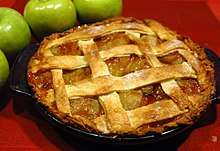
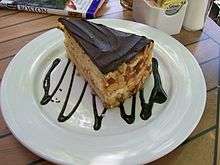
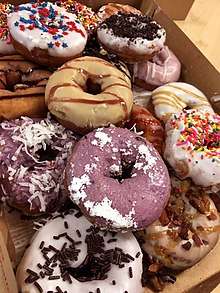
Given the old saying that it's "as American as apple pie", it's no surprise to the traveler that the United States produces delicious pies, especially in the hands of good home bakers and good American-style bakeries and restaurants. Among the better-known varieties are apple pie, cherry pie, blueberry pie, pumpkin pie (especially popular for Thanksgiving), banana cream pie, coconut cream pie, Key lime pie, and lemon meringue pie. Look for regional favorites such as pecan pie and sweet potato pie in the South, and the Pennsylvania Dutch Country's shoofly pie, which is redolent of molasses and brown sugar and which may be baked either as a cake or as a single-crust pie, in gooey wet-bottom or cakey dry-bottom forms, with the true form usually being whichever way your grandma made it. New York cheesecake, which despite its name is closer to a pie than a cake, has a thin graham cracker crust filled with a stiff baked custard made from cream cheese, eggs, and plenty of sugar, and is available throughout the country.
Very good cakes are also made in the United States. The frosted layer cake is an American invention, and chocolate layer cakes covered with chocolate frosting can be found in every city. Louisiana prides itself on King Cake, which was once a rich yeast-bread cake available only between Epiphany and Mardi Gras, and is now even richer, filled with fruit or cream, and available in dozens of flavors and variations year round. The Boston cream pie – which, despite the name is really a layer cake filled with pastry cream and topped with chocolate glaze rather than a pie – was born in Massachusetts and is available across the country. Many popular cakes are sold as cupcakes, which range in size from a single serving that can be easily eaten from the hand, to something the size of a coffee mug and best shared between two people.
Another category of baked items are brownies, blondies (butterscotch brownies that may or may not also have chocolate chips in them) and various kinds of squares (lemon, lime, chocolate-pecan – the potential varieties are endless). The chocolate chip cookie is a national favorite, and bakeries typically offer frosted sugar cookies year-round and cinnamon-y gingerbread cookies during the winter holidays. Doughnuts come in two main types – the raised doughnut and the cake doughnut. On average, you will find better quality doughnuts at a doughnut shop than at a grocery store, although the doughnut shop will close earlier in the day.
Many Americans enjoy pancakes or waffles, and in the South, fried chicken and waffles is a traditional dish. At many of the better establishments in the Northeast, especially in and close to Vermont, real maple syrup is available to pour on your pancakes or waffles. In other parts of the country and in less expensive restaurants, you are likely to be offered brown-colored pancake syrup made from high-fructose corn syrup and artificial maple flavoring. In the South, you may encounter clear, almost flavorless Karo corn syrup, slightly tangy sorghum syrup, or molasses. In Hawaii, you can use coconut or pineapple syrup.
Regional favorites also exist in candy. Tourist-oriented locations offer salt-water taffy at seaside locations and regional favorites, such as maple candy in New England and caramels in the South. Georgia, Louisiana and Texas make sugary pecan pralines; elsewhere in the South, peanut brittle takes the lead. Western New York makes chocolate-enrobed sponge candies. Tennessee adores the round Goo-Goo Cluster candy bar. In the Pacific Northwest, especially during the holiday season, you may be able to find Aplets and Cotlets, which is similar to Turkish Delight with pieces of dried apple or apricot added. In Hawaii, look for chocolate-covered macadamia nuts and chewy Red Coconut Balls.
Ice cream is popular and dominated by regional and national chains. Normal servings tend to be huge, so don't be shy about asking for a "junior" or "kid's" serving.
Generally speaking, you'll find the best results at local, non-chain bakeries and the restaurants supplied by them. The mass-produced supermarket brands can be awful and made with preservatives and the cheapest possible ingredients, such as high-fructose corn syrup. However, some grocery stores, especially smaller chains in larger cities, have added upscale delis and expanded their offerings by selling artisanal breads and desserts made by local or regional bakeries.
South America
Argentina
Mignoncitos are popular, crusty, white bread rolls with a fluffy texture inside that is perfect for sopping up sauce or spreading with butter. They are made in the French style, and take their name from the French word mignon, which refers to their smaller size.
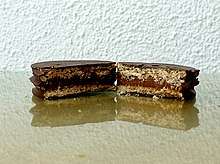
The flavor of choice for sweets is caramel-flavored dulce de leche. Expect to find this not only in cakes and as a regionally famous candy, but also as a topping for toast, pancakes, and ice cream. The Vauquita (little cow) candies are candies made from dulce de leche; they are firm caramel on the outside, and soft inside. For a portable indulgence that is characteristic of Argentina, find some alfajores. These are sandwich cookies filled with dulce de leche or sometimes fruit jam, and usually coated with either powdered sugar, white meringue, coconut, or a thin chocolate coating.
Brazil
Brazil is the land of pão de queijo, wonderful cheese rolls that are made with tapioca flour, stuffed whichever cheese is popular and available in each region.
Colombia
Colombia has a surprising variety of breads, especially breads with cheese. Stop in the neighborhood panadería to find good breads at a reasonable price. On a gluten-free diet? Look for ball-shaped almojábanas, which are usually made with tapioca flour, or arepas, which are made with cooked cornmeal. Most cakes in Colombia feature fruits, such as the strawberry-and-cream-filled roll called Brazo de Reina.
Peru
In the cities, many people go to the local bakeries twice a day: once early in the morning to get some pan francés (French bread) or other bread for their breakfast, and again the late afternoon to get some fresh bread for the lonche, or afternoon tea. Whole grain breads are hard to find. Avoid pan popular, which tends to be inferior.
Around Cuzco in southern Peru, you will find large, round, slightly sweet loaves of pan chuta, which are bought both for eating and as gifts for people whose homes you visit. They often contain anise or other flavors, and may contain raisins. In northern Peru, near Piura and Trujillo, you may find a fried bread called pan cachanga being served on Sundays. Pan de maiz, or corn bread, is the modern descendant of the ancient Incans' corn tortillas. If you're planning a trek, then look for pan vinco, which keeps well for several days.
Rice pudding is one of the most common desserts. Lúcuma-flavored ice cream is a very popular orange-colored ice cream that is found only rarely outside of Peru, because so little lúcuma fruit is grown elsewhere.
Asia
China
In China, bread is less present, though in Northern China, very good flatbread is available from vendors who make it on griddles, and is particularly associated with the Muslim community. Baozi (包子) — buns — are widely available, often filled with roast pork and onions, though there are numerous possible fillings. There also is a version without filling known as mantou (馒头). They are eaten either as a snack or meal in themselves or as part of what in Cantonese is called yum cha, also called dim sum: food to be eaten with tea. Baozi are quite commonly steamed, but baked baozi also exist and are traditional, and mantou can also be deep fried. Of course, dumplings (jiaozi, 餃子) are also very widespread, but they are steamed or fried and are really more about the filling than the wrapper, whereas baozi have enough of a "wrapper" for its taste as well as its texture to be an important part of their appeal.
Japan
Traditional Japanese desserts are often based on rice, in particular mochi, a uniform but still soft paste of pounded glutinous rice. The paste is filled with any number of flavors that are well worth exploring when you are in Japan, though the most classic is probably adzuki beans. The Japanese have also adopted and adapted Western-style bread and confectionery in modern times. They make fantastic pastries that represent a fusion of French techniques with Japanese ingredients and taste. They are often significantly less sweet than European and American desserts. Matcha – a strong, high-quality green tea – and adzuki beans are common ingredients, along with many others shared in common by Europeans. The Japanese also make equally good and varied rice cakes, which form a kind of savory, crunchy counterpart to their pastries.
Malaysia and Singapore
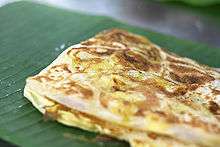
Malaysia and Singapore feature more rice than bread as their staples, and if you go to any good pasar malam (night market), you can find a selection of kuih, which are traditional, usually small rice-baked cakes.
There is at least one famous Malaysian and Singaporean bread: roti canai/roti prata, a flaky bread originally made by immigrants from Tamil Nadu, India, and usually accompanied with a savory chicken/lamb/goat and potato curry, although other sauces may be used. Capati (also spelled chapatti) is very common in Malaysia and usually eaten the same way.
Regular Western-style bread is also used in several local dishes, such as kaya toast and roti john. In addition, many people enjoy lempeng (non-stuffed pancakes) or jemput (stuffed pancakes) for breakfast. Both are made with wheat flour, commonly combined with coconut, bananas or jackfruit (the sweeter nangka or the more savory cempedak).
Middle East
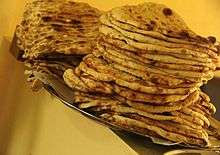
Middle Eastern and South Asian cuisines are famous for soft flatbread of wheat (naan in Persian, lavaş in Turkish), which tastes best when it has just come out of the oven.
The Levant and Turkey produce fantastic desserts as well, including baklava and knafeh, which use pistachios or walnuts and, in the case of knafeh, cheese, and mamoul, which has a spice-laden date-paste filling.
South Asia
South Indian cuisine's staples include uttapams, which are savory flatbreads with various ingredients such as onion and chillis or mixed vegetables in the dough, and masala dosas, which are paper-thin, rolled and stuffed with various fillings, for example potatoes, onions and chillis. Samosas, which are fried dough stuffed with ingredients such as a spicy potato filling, are a ubiquitous snack and appetizer in many parts of North India and adjacent areas of Pakistan and Bangladesh. Numerous types of flatbread are staples of North Indian cuisine, including roti, naan, chapati, kulcha, and paratha, and the variety of flavors and in some cases, fillings, is almost limitless.
South Asian desserts are extremely varied and generally extremely sweet. Milk is often used. Other common ingredients include gram (lentil) flour, which is called besan in Hindi, nuts such as cashew (kaju) and pistachio (pista), and carrots (gajar). Many South Asian desserts are flavored with cardamom and/or a touch of rose water, and they are often fried or boiled.
Thailand
Although Thais typically eat rice instead of bread, there is a distinctive flatbread dish from the city of Ayutthaya known as roti saimai, in which a flatbread is rolled around some candy floss.
Vietnam
Vietnam is known for the banh mi, a sandwich made with a Vietnamese baguette, which is derived from the French baguette except that it uses rice as well as wheat flour. The classic filling for the sandwich is roast pork, along with sliced cucumbers, shredded daikon, paté, hot peppers, mayonnaise and cilantro. Other common varieties include chicken (banh mi ga) and vegetarian.
Europe
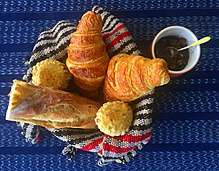
Austria and Hungary
Vienna is so famous for its pastries that even the French, with their different and comparably great pastries, call pastries in general viennoiserie. The neighboring country of Hungary and Germany's Bavaria have similar traditions. Viennese pastries are generally rich with cream and butter and often include delicious dark chocolate or custard, although one of the most famous Austrian desserts is the Strudel (called retes in Hungary). Composed desserts such as Kaiserschmarrn, a delicious mix of caramelized dough with apples and rum-soaked raisins, are also available.
France
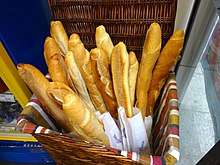
The archetypal bread of French cuisine is the baguette, a plain wheat roll. Second most common after the baguette are petits pains (small breads), which come in several varieties. France is also the land of the croissant and pain au chocolat, both of which are best eaten when just baked, though bakeries will normally reheat them for you if you ask. French bread can also be seasoned with poppy seeds or walnuts.
In addition, there is an immense variety of wonderful sweet and savory tarts of all descriptions. A famous French savory tart is the quiche Lorraine, from the northern French region of the same name. Ingredients often used in sweet tarts include cream, custard, strawberries, raspberries, almond paste, pears, apples, apricots and chocolate. The chausson, a bready confection that's a good snack, is often stuffed with apples (sweet) or red sweet peppers and onions (savory). And the famous crèpe, a thin slice of eggy dough either plain or with either savory or sweet filling, springs from Brittany.
Sandwiches (actually called sandwiches, pronounced "sahnd-WEESH" in French) are also quite common for informal eating, especially the croque monsieur and croque madame. The croque monsieur is a fatty sandwich of ham with cheese (most commonly Emmental or Gruyère) that is often grilled with butter; a croque madame is topped with an egg in addition. You can also get a regular sandwich of bread that's simply been filled with meat, grilled vegetables and/or cheese in any combination at a boucherie or boulangerie or buy the ingredients and make your own, an excellent way of saving money and having your own picnic.
Germany


German bread (Brot) is generally of very high standard and available in many varieties. Germany probably has more varieties of bread than almost every other country – so many varieties that you could eat a different type of bread every day for a year. Breads made from whole grain and/or sourdough are particularly plentiful and usually of good quality. In fact, bread is one of the things Germans miss the most when abroad for longer periods of time. Fresh pretzels are available in nearly every bakery, in the traditional twisted shape as well as smaller knots and rings. If you want something more substantial as a snack, look for pretzels that have been split and filled with butter or cream cheese.
Another particular German treat with mind-boggling variety are Brötchen, bread rolls. They are frequently eaten at lengthy German breakfasts but also a staple of street food such as Bratwurst-Brötchen or belegte Brötchen. When the word belegte or belegtes is used to describe words like Brot and Brötchen, it means sandwich. Sandwiches are generally excellent in Germany because the bread and the ingredients used for the filling are of high quality, and many bakeries sell ready-made sandwiches in the middle of the day. The term sandwich has also entered the German lexicon and is often understood as being subtly distinct from belegtes Brot. The term belegtes Brot is rarely used in some regions where the local dialect prevails. In Berlin, people will say Stulle, and in Saxony the term Bemme or Fettbemme (originally with lard, now often with butter) is used.
German pastries are quite good, and in Bavaria, are quite rich and varied, similar to those of their southern neighbor, Austria. Fruit pastries are common, with apples cooked into pastries year round, and cherries and plums making their appearances during the summer. Many German baked goods also feature almonds, hazelnuts, and other tree nuts. Popular cakes often pair particularly well with a cup of strong coffee. If you want some small though rich pastries, try what depending on region are called Berliner, Pfannkuchen or Krapfen. These are something like holeless doughnuts, made with soft dough. Many fillings are possible, and some of them include liqueurs such as Eierlikör, a very potent egg liqueur. In southern Germany, particularly Franconia Hiffenmark, rosehip jam is the traditional filling of Krapfen. They're particularly common around Carnival and an old tradition is to fill some of them with mustard as a "joke".
When it comes to other baked goods, Germany has the Amerikaner (named for the ammonium bicarbonate leavening and not the USA) — a round, just over hand-size, saucer-shaped piece of dough that is covered with chocolate and sugar frosting. Then there is the Bamberger Hörnchen, which is similar in appearance and taste to French croissants but contains more butter. In southern Germany, you will see hard, often heart-shaped Lebkuchen cookies, packed with powdered ginger and cloves, decorated with hard royal icing, and usually packaged on a string, so they can be worn as a necklace. These cookies keep for months and pack well, so they are popular gifts to bring home, but they might be more popular back home for their appearance and sentimental associations than for their strong, spicy flavors. Soft Lebkuchen, which hold their shape by sitting upon a bland wafer, can be equally spicy and may be dipped in chocolate.
Avoid buying breads and other baked goods at the grocery store. While you may luck into something acceptable, you will get much better quality at a bakery for a very similar price. However, surprisingly enough, some discounters have started to emphasize quality over price in their marketing and now "bake fresh" – i.e., they have virtually the same frozen dough delivered to their franchises as many chain bakeries and the results can be similar, but never approach the true artisanal baked goods found in smaller or more expensive bakeries.
Italy
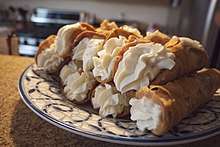
Italy is famous for sweet desserts. In particular, Naples is well-known for its cannoli, baba au rhum, Neapolitan cheesecake (torta di formaggio) based on ricotta cheese, and many other classic pastries.
Italy is also famous for two types of savory breads: Pizza, again most associated with Naples, though also in a Roman variety, and focaccia. Pizza in Italy is made from a very thin slice of good-quality bread, typically with a base of fresh mozzarella di bufala, basil and tomatoes. This is called pizza margherita, and prosciutto is the most common thing to add to it. Neapolitan-style pizza must be eaten with a knife and fork. Roman pizza is a bit thicker though still thin and can have a variety of toppings.
Focaccia, much appreciated in Northern Italy, is thicker bread with other ingredients in the batter. Sweet ingredients such as grapes may be used, but it is more common for focaccia to be savory, with ingredients such as potatoes and rosemary, tomatoes and olives, salami, artichoke hearts, mushrooms, cheeses, squash, or onions. The combinations are limited only by the imagination of the baker and the ingredients s/he has at hand.
Italy is also the wellspring of the panino (plural: panini), the Italian word for "sandwich" (never use "panini" for one sandwich in Italy, nor the irregular plural of "paninis"). Panini are usually quite good, as Italy is a major farming country with farms rarely more than a relatively short drive from wherever you are, so Italian produce is terrific, and so are the meat products (often salumi - cured or dried meats such as prosciutto, salame, mortadella and bresaola) and cheeses.
Nordic countries
- See also: Nordic cuisine
.jpg)
The traditional cereals in the Nordic countries are wheat, rye, barley, and oats. In many breads, two or more cereals are mixed. The modern trend is sweet bread mostly of wheat, with seeds and crushed cereals, but there is different traditional bread. In Finland there is a rich older culture influenced by Russian cuisine, with unsweetened rye breads, malt sweetened rye breads and different breads of wheat, barley and oats (big bakeries and thus supermarkets often make compromises with the tradition for efficiency).
While hard bread (knäckebröd/knekkebrød) is ubiquitous and is traditionally eaten at major holidays such as Christmas and Midsummer, the taste is not always a great sensation. Sandwiches are popular, especially the Danish smørrebrød, which can contain enough ingredients to make up a full meal.
Nordic hotel breakfasts can offer several types of bread, to be eaten with cheese and meat spreads.
Denmark and Sweden have a particularly wide range of cakes and pastries, usually flavored by wild berries. Danish pastries are locally known as wienerbrød, since they were introduced by bakers from Vienna.
Russia
Russian cuisine is known for heavy, soft bread, as a side order to virtually every dish.
Religions
Traditional Chinese and Vietnamese religion
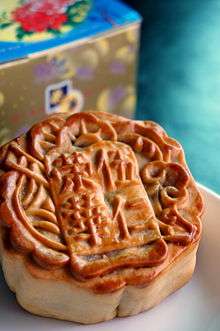
Very rich and often quite expensive mooncakes are eaten and given as presents around the time of the Mid-Autumn Moon Festival. Mooncakes come in a great number of varieties. Traditional fillings include red bean paste, lotus seed paste and mixed nuts with or without ham, and salted duck eggs, symbolizing the moon, are also often included. Nowadays, you can find mooncakes with chocolate or pineapple filling, too. Though mooncakes are often quite large, mini-mooncakes are also sold and are a good option if you'd like to try some without paying a lot. You can find mooncakes anywhere where Chinese or Vietnamese people live, and they are very commonly sold in metal boxes in stores and supermarkets and keep fresh for a long time.
Christianity
Quite a few baked items are traditional for the Christmas season, others for the Easter season. Stollen in the German-speaking world and beyond and other types of fruitcake with candied fruits in many places, some hard and some soft like Italian pannetone, originally from Milan, are traditional for the Christmas season. In Mexico, the southern United States, and much of the Spanish-influenced world, king cake marks the end of Christmas on Epiphany, and may be seen until the beginning of Lent.
Hot cross buns, with their clear symbolism, are traditional Good Friday fare in Britain and British-influenced lands.
In Mexico, pan de muerto is baked for the Day of the Dead, which begins on October 31st each year.
Bread also plays a huge role in Mass with the question whether the host should be leavened or not one of the major theological reasons for the split of Orthodox and Catholic Christianity. Later on the question whether the host is literally or only figuratively the body of Christ was one of several theological disagreements resulting in the Protestant Reformation causing a schism.
Islam
There are many special foods for Eid al-Fitr and Ashura. For example, in Malaysia, there are many kuih (small cakes) that are eaten on what's locally called Hari Raya Puasa (Eid el-Fitri). Many of them are made with agar-agar, but quite a few others use rice flour.
Judaism
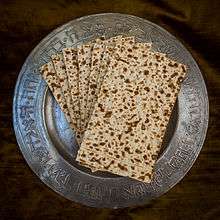
Judaism, which originated in what is today Israel and the West Bank but spread to every continent, places a particular emphasis on unleavened bread (matzo) during Passover, one of the highest Jewish holidays. Matzo comes in several varieties, with shmura matzo, which is round like a flat pita and produced by the Chasidim, lately increasing in popularity. Passover cuisine traditionally includes matzo in several different guises. In Ashkenazic cuisine (that of the Central and Eastern European Jews and their descendants in the Americas, Israel, Australia and other places), this includes matzo ball soup and matzo brei (matzo fried with egg) but also artisanal cake made out of potato flour or almond flour with marzipan and fruit jam, as potatoes and almonds are kosher l'Pesach.
During the rest of the year, in Ashkenazic homes, challah (an often eggy braided bread) is traditional for Kabbalat Shabbat (Welcoming the Sabbath) dinners and many other occasions.